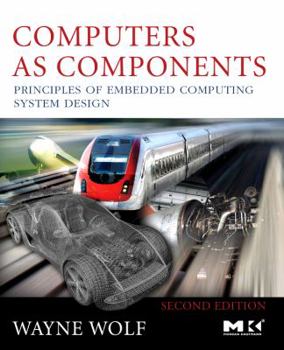Computers as Components: Principles of Embedded Computing System Design
Select Format
Select Condition 
Book Overview
Computers as Components, Second Edition, updates the first book to bring essential knowledge on embedded systems technology and techniques under a single cover. This edition has been updated to the state-of-the-art by reworking and expanding performance analysis with more examples and exercises, and coverage of electronic systems now focuses on the latest applications. It gives a more comprehensive view of multiprocessors including...
Format:Paperback
Language:English
ISBN:0123743974
ISBN13:9780123743978
Release Date:June 2008
Publisher:Morgan Kaufmann Publishers
Length:544 Pages
Weight:2.45 lbs.
Dimensions:1.3" x 7.5" x 9.3"
Customer Reviews
3 ratings
explains hierarchy of design, from devices to operating system
Published by Thriftbooks.com User , 17 years ago
The average person in the US now uses a computer. Typically running a Microsoft operating system or unix or linux. Yet there is an entire ecosystem of embedded computers out there, invisible to most people. Wolf's text explains how you can program such computers as well as design the circuitry in which they might exist. Here, "computer" in the book essentially means microprocessor plus some off-chip memory. The book surveys two main microprocessor families - ARM and SHARC. These are not the most common microprocessors. (Which might be by Motorola.). But Wolf chooses them to illustrate different design ideals for their instruction sets. One nice thing about the book is that you get a direct grasp of the hierarchy of design and logic. Climbing from the low level devices of latches, gates, flip-flops and the like, to the microprocessor and its machine language, to the corresponding and far easier to use assembly language. Then, upwards to an operating system.
Good intro to embedded development
Published by Thriftbooks.com User , 18 years ago
Do you know what percentage of all computers run Windows or some kind of Unix? Guess. I'll give you the answer later. This book is about all the other computers out there - the ones in your car's airbags and antilock brakes; in your watch, cellphone, TV and its remote, CD player, and computer keyboard; in your implanted defibrillator. Wolf starts with an introduction in terms of a personal-scale, practical example. Next he goes into what a CPU is in lots more detail than most programmers ever think about - the kind of detail you need when the CPU interacts so intimately with the other components in the system. Maybe you never heard of the ARM or SHARC processors (unless you already do embedded work), but they're good representative choices. ARM is an incredibly common core architecture, with supervisor mode and memory mapping, what it takes to run a "real" OS, whether it does or not. SHARC is a signal processor - a real processor, but with extras for fast artihmetic processing. Together, the two stand adequately for a large fraction of the embedded processors in use.The next chapter goes over hardware basics: the bus, memory mapped IO, interface issues, and in-circuit debugging. The rest of the book generally covers higher level issues: software design, embedded and real-time OSs, coprocessors, and networks. Although coverage of IIC and similar board-level communication is good, I found the ethernet discussion weak. Anyone working at this level is likely to need 802.2 protocols, which I did not see mentioned. The book's strengths far outnumber its occasional soft spots, though. Embedded computing is a huge, many faceted field, so no book can cover more than a tiny fraction of what it means. Still, this addresses a broad, useful range what you need to program 99% of the computers out there - because only about 1% run Windows or Unix. //wiredweird
Good attempt at describing the embedded process
Published by Thriftbooks.com User , 23 years ago
This book was used as a text book at a graduate level class in embedded design at University of St Thomas, Minnesota. I am also a professional embedded engineer (both hardware and software). What this book does the best is to provide a framework for embedded design. There are various examples in the text on the embedded design process via the requirements/specifications/hardware architecture/software architecture/component design/test process.This has definitely impacted both my understand on a theoretical level as well as my design process at work.Highly recommended!






